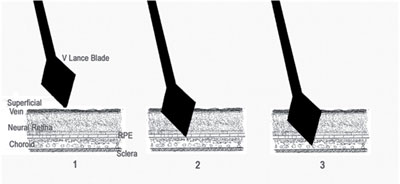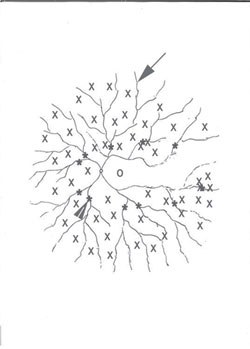Revascularization by anastomotic decompression improves retinal vein occlusion
Novel venous drainage is established through induction of multiple retinochoroidal venous anastomoses in the posterior periphery.
Revascularization by anastomotic decompression in conjunction with vitrectomy offers a reproducible and significant treatment for improving hemodynamics in all forms of retinal vein occlusion.
It establishes novel venous drainage by connecting superficial, blocked retinal veins to underlying open choroidal vasculature through the induction of multiple retinochoroidal venous anastomoses in the posterior periphery. The steps are as follows:
1. A complete three-port vitrectomy is performed with elevation and removal of the hyaloid to the equator.
2. A 20- or 23-gauge microvitreoretinal blade is advanced perpendicularly through secondary or tertiary venous elements to the point of bisection and stopping within a deep choroidal vessel to induce the anastomoses. The bottle may be elevated for tamponade as needed.
3. Two to three rows of endolaser photocoagulation are placed in a semi-confluent pattern around the cut-down site, and light panretinal photocoagulation is placed in the retinal area drained by the down-stream engaged vessel.
4. An air-fluid exchange is performed.
5. For small incision surgery, it is imperative to avoid postoperative hypotony; accordingly, sclerotomy sites should be deemed watertight.
6. Face-down positioning until the air bubble dissipates.
7. Postoperative monitoring.
Three-port vitrectomy
A complete three-port pars plana vitrectomy is performed to elevate and remove the hyaloid to the equator. Twenty- or 23-gauge is technically interchangeable for the procedure. Sclerotomy site selection should allow ease of access to veins without severe torsion of blade. If the hyaloid is taut and appears adherent after reasonable attempts at elevation, step two should be initiated. There will be a clear delineation of the hyaloid after this step.
The microvitreoretinal blade should enter the vein perpendicularly and be advanced through Bruch’s membrane to enter a superficial choroidal vessel (Figure 1). The passing of the blade is slow. The blade may be left in the incision for 2 to 3 seconds to aid in tamponade. Removal of the blade from the incision may result in minimal bleeding, which may be evacuated with soft-tip silicone suction. For a central retinal vein occlusion, six to eight sites are induced. For branch and hemiretinal vein occlusion, anastomoses sites are selected within the distribution of the blocked vein. The sites are best placed 1 to 2 disc diameters anterior to the major vascular arcades (Figure 2).
|
|
|
|
Schematic representation (Figure 1 on left)
of the cross-sectional posterior eye wall showing the passage of the
microvitreoretinal blade through vein to the choroidal level. Retinal diagram
(Figure 2 on right) detailing the surgical sites for anastomoses induction and
panretinal photocoagulation.
Images: Grant CA, John T |
|
Endolaser photocoagulation is placed around the anastomoses induction sites and periphery. The laser should be of laser demarcation intensity around the anastomoses sites and standard panretinal photocoagulation quality in the periphery. At the cut-down site, care must be provided not to devitalize the choriocapillaris in the bed. A semi-confluent pattern often achieves this goal.
Air-fluid exchange
A complete air-fluid exchange is performed to presumably act as scaffolding for venous growth into the anastomosis site, in addition to acting to support the retinal punctures until maturation of the laser scars. Air exchanges may result in minimal oozing from the cut-downs. An increase of IOP in 1-minute bursts with suction often resolves the bleeding. Unipolar cautery should be avoided. A 2- to 3-disc diameter segment of the upstream vein may be photocoagulated to decrease blood if bleeding persists. A coating of the vessel with white demarcation quality spots results in reversible venous constriction.
Systemic blood pressure should be monitored and treated throughout the duration of the case. Regression to preoperative hypertension is the normal course. Sclerotomies should be actively checked with fluid for leaks and sutured accordingly to prevent overt and relative hypotony.
Face down and opposite decubitus positioning is important until the bubble dissipates. Forty-five minutes out of the hour is encouraged.
Postoperatively, a small degree of hemorrhage is common within 24 hours of the procedure. Usually, visualization of all retinal detail is possible. This should clear within 1 to 2 weeks. The rare dense hemorrhage lasting more than 2 weeks should be removed to prevent scar formation at the induction sites. Any systemic process resulting in Valsalva should be avoided and/or treated within the first 3 weeks, ie, coughing, bending and straining. Anastomoses should be functioning within the first 2 to 3 weeks (Figures 3 to 6). Topical NSAIDs may be taken after 4 weeks. Anti-VEGF supplementation may be attempted after 6 weeks, as needed clinically.
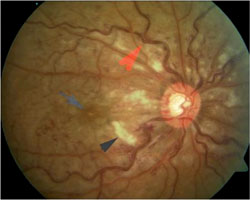 Figure 3. Fundus photo of an ischemic central retinal vein occlusion; red arrow on the engorged retinal vein, blue arrow on a cotton wool spot and gray arrow on cystoid macular edema. |
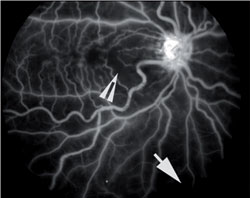 Figure 4. Fluorescein angiogram of the ischemic central retinal vein occlusion; arrow heads demonstrating areas of capillary nonperfusion. |
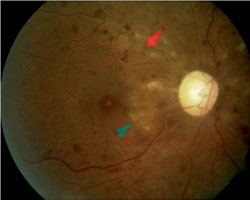 Figure 5. Fundus view, 2 weeks after revascularization by anastomotic decompression treatment, showing decreased venous congestion and cotton wool spot, red and blue arrows respectively. |
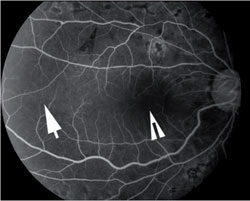 Figure 6. Corresponding fluorescein angiogram to Figure 5 demonstrating restoration of capillary perfusion. |
Revascularization by anastomotic decompression may result in normalization of hemodynamic characteristics and vision in ischemic and non-ischemic retinal venous occlusion when performed promptly.
References:
- Funk M, Kriechbaum K, Prager F et al. Intraocular concentrations of growth factors and cytokines in retinal vein occlusion and the effect of therapy with bevacizumab. Invest Ophthalmol Vis Sci. 2009;50(3):1025-1032.
- McAllister IL, Vijayasekaran S, Chen SD, Yu DY. Effect of triamcinolone acetonide on vascular endothelial growth factor and occludin levels in branch retinal vein occlusion. Am J Ophthalmol. 2009;147(5):838-846.
- Scott IU, VanVeldhuisen PC, Oden NL: SCORE Study report 1: baseline associations between central retinal thickness and visual acuity in patients with central retinal vein occlusion. Ophthalmology. 2009;116(3):504-512.
- Calvin A. Grant, MD, can be reached at Advanced Retinal Institute, 7808 College Drive, Suite 1NW, Palos Heights, IL 60463; e-mail: parceled@aol.com.
- Thomas John, MD, is a clinical associate professor at Loyola University at Chicago and is in private practice in Tinley Park and Oak Lawn, Ill. He can be reached at 708-429-2223; fax: 708-429-2226; e-mail: tjcornea@gmail.com.

![]()
Retinal venous occlusions, either central-, hemi- or branch-retinal vein occlusion, cause a backup of venous return with venous engorgement, retinal hemorrhages and possible macular edema, depending on the area of retinal involvement. Such blockage of the venous vasculature can be ischemic or non-ischemic, and in the former case, vascular endothelial growth factor associated potential complications can ensue. If macular edema develops, it can result in painless decrease in visual acuity.
To date, there is no single consistently effective medical treatment for retinal venous occlusions. In the absence of an effective medical therapy, surgical intervention may be considered in selective cases.
In this column, Dr. Grant discusses his surgical technique of revascularization by anastomotic decompression, combined with posterior vitrectomy in retinal venous occlusions. Continued monitoring of surgical outcome in patients undergoing revascularization by anastomotic decompression in larger series and longer follow-up are warranted to evaluate its overall efficacy.
– Thomas John, MD
Editor, Surgical
Maneuvers Column

